Introduction
Excel is a naturally powerful tool for data analysis that enables users to manipulate, analyze, and visualize large amounts of data quickly and easily. With built-in features such as pivot tables, data tables, and various statistical functions, Excel is widely used in many industries, from finance and accounting to marketing and sales. This article highlights the essential role of Excel in data analysis and its significance in today’s data-driven world.
Learning Outcomes
- Using Excel’s robust features, learn the integral data analysis process, including data cleaning, transformation, and analysis.
- Gain proficiency in 15 key Excel functions for data analysis.
- Develop skills in creating and customizing various charts and graphs in Excel.
- Learn to implement advanced data analysis techniques.
- Understand how to perform statistical analysis and create models like simple linear regression using Excel’s Analysis ToolPak
This article was published as a part of the Data Science Blogathon.
Table of Content
- Introduction
- Introduction to Excel for Data Analysis
- Types of Data Analysis With Microsoft Excel
- 15 Essential Excel Data Analysis Functions
- FREE Course on Excel for Data Analysis
- Some of the Methods for Data Analysis in Excel
- 1. Ranges and Tables
- 2. Data Cleaning: Text Functions, Dates and Times
- 3. Conditional Formatting
- 4. Sorting and Filtering
- 5. Subtotals with Ranges
- 6. QuickAnalysis
- 7. Understanding Lookup Functions
- 8. PivotTables
- 9. Data Visualization in Excel
- 10. Data Validation
- 11. Financial Analysis
- 12. Working with Multiple Worksheets
- 13. Formula Auditing
- 14. What-if Analysis
- Guide on Using Excel for Data Analysis
- Simple Linear Regression Model in Microsoft Excel
- Dataset in Excel for Data Analysis
- Conclusion
- Frequently Asked Questions
Introduction to Excel for Data Analysis
Data analysis is a valuable skill that can help you make better judgments. Microsoft Excel is one of the most used programs for data analysis, with the built-in pivot tables being the most popular analytic tool. Excel for data analysis provides a user-friendly platform where individuals can efficiently organize and interpret data sets. Whether you are working in finance, marketing, or any other industry, mastering the intricacies of Excel for data analysis can significantly enhance your ability to derive meaningful insights and inform strategic decision-making.
Microsoft Excel allows you to examine and interpret data in various ways. The information could come from several different places. A variety of formats and conversions are available for the data. Conditional Formatting, Ranges, Tables, Text functions, Date functions, Time functions, financial functions, Subtotals, Quick Analysis, Formula Auditing, Inquire Tool, What-if Analysis, Solvers, Data Model, PowerPivot, PowerView, PowerMap, and other Excel commands, functions, and tools can all be used to analyze it.
Also Read: Step-by-Step Exploratory Data Analysis (EDA) using Python

Types of Data Analysis With Microsoft Excel
Microsoft Excel is a powerful tool for various types of data analysis. Here are some common types of data analysis that can be performed using Excel:
1. Descriptive Analysis
Descriptive analysis involves summarizing and describing the main features of a dataset.
- Summary Statistics: Calculate the mean, median, mode, standard deviation, and range using functions like AVERAGE, MEDIAN, MODE, STDEV, and MAX-MIN.
- Data Visualization: Create charts and graphs (e.g., bar charts, histograms, pie charts) to visualize data distributions and trends.
- PivotTables: Summarize large datasets by creating PivotTables to calculate totals, averages, and other summary statistics quickly.
2. Exploratory Data Analysis (EDA)
EDA involves analyzing data sets to find patterns, relationships, and anomalies.
- Sorting and Filtering: Sort data and apply filters to explore subsets of data.
- Conditional Formatting: Highlight patterns and outliers using conditional formatting rules.
- Scatter Plots: Create scatter plots to explore relationships between two numerical variables.
- Box Plots: Use box plots to visualize the distribution and identify outliers.
3. Inferential Analysis
Inferential analysis involves making inferences and predictions about a population based on a sample of data.
- Hypothesis Testing: Use the Analysis ToolPak to perform t-tests, ANOVA, chi-square tests, and other statistical tests.
- Confidence Intervals: Calculate confidence intervals to estimate population parameters.
4. Predictive Analysis
Predictive analysis uses historical data to predict future outcomes.
- Regression Analysis: Use the Analysis ToolPak to perform linear and multiple regression analysis to predict the value of a dependent variable based on one or more independent variables.
- Trend Analysis: Use trendlines in charts to identify trends and make forecasts.
5. Prescriptive Analysis
Prescriptive analysis provides recommendations for actions based on data.
- What-If Analysis: Use tools like Scenario Manager, Goal Seek, and Data Tables to explore different scenarios and their outcomes.
- Solver: Optimize decision-making by finding the best solution to a problem with constraints using Solver.
6. Diagnostic Analysis
Diagnostic analysis aims to determine why something happened by identifying causes and correlations.
- Correlation Analysis: Calculate correlation coefficients to measure the strength and direction of relationships between variables.
- Drill-Down Analysis: Use PivotTables to drill down into data for more detailed analysis.
7. Time Series Analysis
Time series analysis involves analyzing data points collected or recorded at specific intervals.
- Line Charts: Create line charts to visualize trends over time.
- Moving Averages: Calculate moving averages to smooth out short-term fluctuations and highlight longer-term trends.
- Seasonal Decomposition: Decompose time series data into trend, seasonal, and residual components using add-ins or custom formulas.
8. Financial Analysis
Financial analysis involves evaluating the financial health and performance of an organization.
- Financial Ratios: Using built-in functions, calculate liquidity, profitability, and solvency ratios.
- Cash Flow Analysis: Analyze cash flow using formulas and templates for cash flow statements.
- Budgeting and Forecasting: Use Excel’s financial functions to create budget models and financial forecasts.
Also Read: How to Become a Finance Analyst?
9. Text Analysis
Text analysis involves analyzing textual data to extract meaningful information.
- Text Functions: Use functions like LEFT, RIGHT, MID, FIND, and SUBSTITUTE to manipulate and analyze text data.
- Data Cleaning: Clean text data by removing duplicates, trimming spaces, and standardizing formats.
- Sentiment Analysis: Perform basic sentiment analysis using keyword-based approaches and Excel formulas.
10. Geospatial Analysis
Geospatial analysis involves analyzing data with a geographical component.
- Mapping Tools: Use Excel’s built-in map charts to visualize data geographically.
- Geocoding: Convert addresses into geographical coordinates using external tools or APIs and then analyze the data in Excel.
15 Essential Excel Data Analysis Functions
Excel has hundreds of functions, and trying to match the proper formula with the right kind of data analysis can be overwhelming. The most valuable functions don’t need to be difficult. You’ll wonder how you lived without fifteen easy functions that will increase your ability to interpret data.
1. Concatenate
When conducting data analysis, the formula =CONCATENATE is one of the simplest to understand but most powerful. It allows text, numbers, dates, and other data from numerous cells to be combined into a single cell.
SYNTAX = CONCATENATE (text1, text2, [text3], …)

2. Len ()
In data analysis, LEN shows the number of characters in each cell. It’s frequently used when working with text that has a character limit or when attempting to distinguish between product numbers.
SYNTAX = LEN (text)
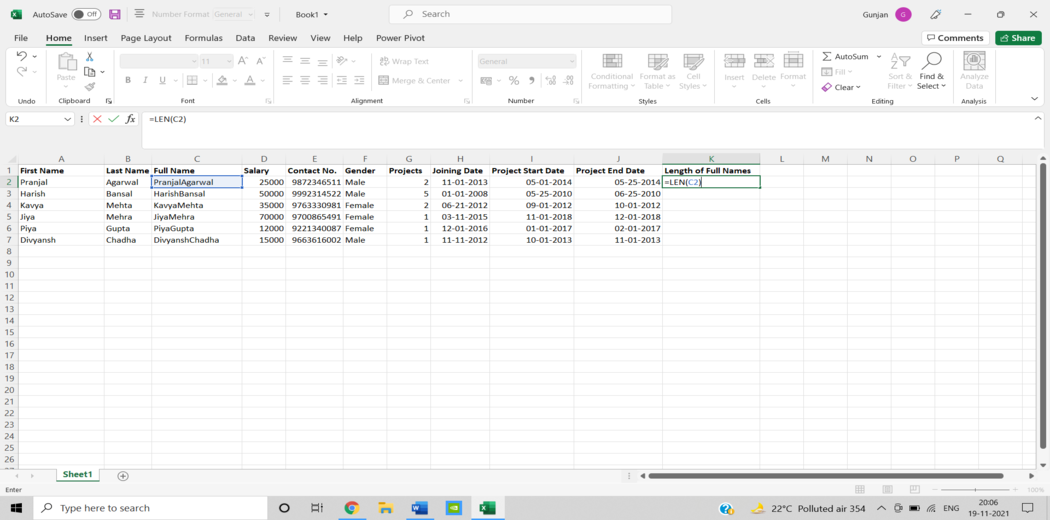
3. Days ()
The number of calendar days between two dates is calculated using this function = DAYS.
SYNTAX =DAYS (end_date, start_date)
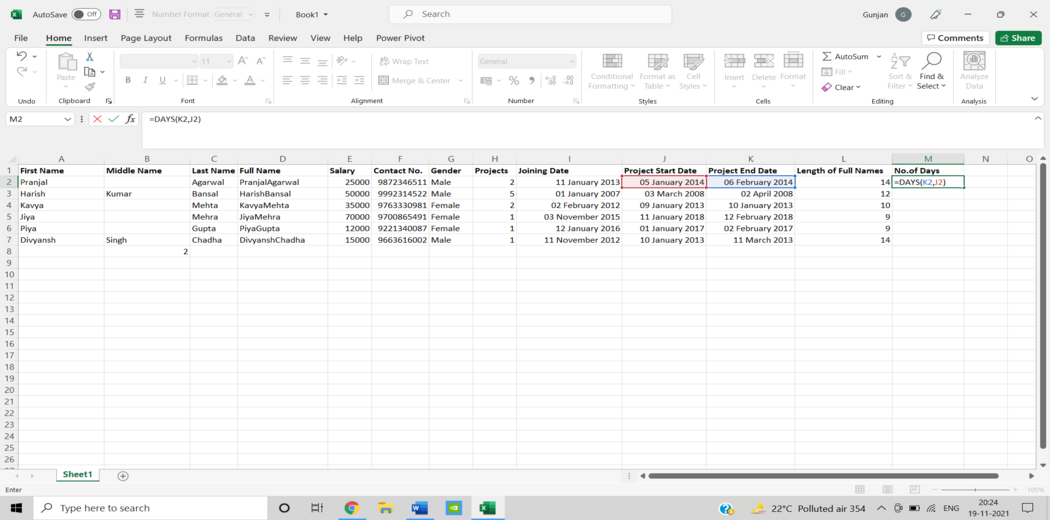
4. Networkdays
The number of weekends is automatically excluded when using the function. It’s classified as a Date/Time Function in Excel. The net workday function is used in finance and accounting to determine employee benefits based on days worked, the number of working days available throughout a project, or the number of business days required to resolve a customer problem, among other things.
SYNTAX = NETWORKDAYS (start_date, end_date, [holidays])
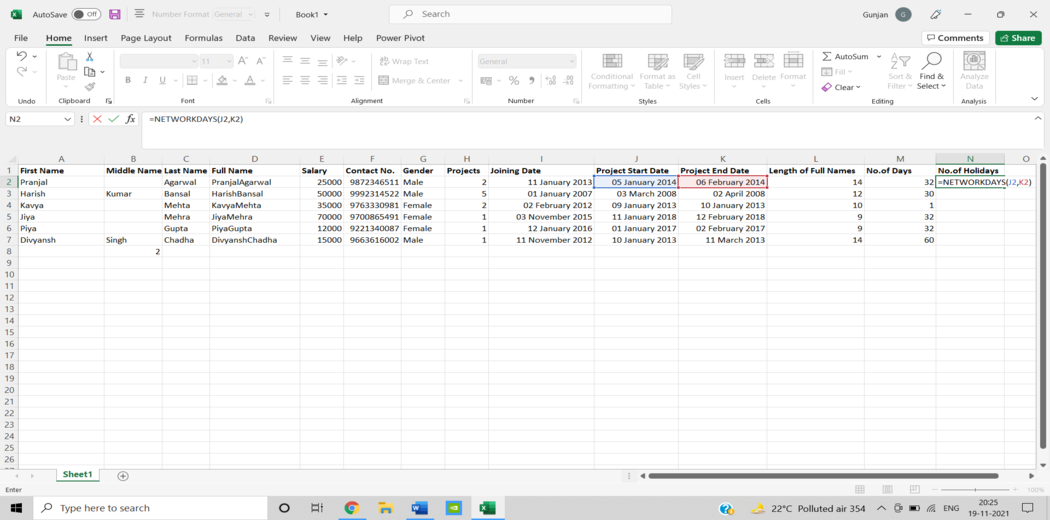
5. Sumifs()
One of the “must-know” formulas for a data analyst is =SUMIFS. =SUM is a familiar formula, but what if you need to sum data based on numerous criteria? It’s SUMIFS.
SYNTAX = SUMIFS (sum_range, range1, criteria1, [range2], [criteria2], …)

6. Averageifs()
AVERAGEIFS, like SUMIFS, lets you take an average based on one or more parameters.
SYNTAX = AVERAGEIFS (avg_rng, range1, criteria1, [range2], [criteria2], …)

7. Countsifs()
The COUNTIFS function is yet another powerful Excel data analysis tool. It’s a lot like the SUMIFS function. The COUNTIFS function counts the number of values that satisfy a set of conditions. As a result, it doesn’t need a sum range like SUMIFS.
SYNTAX = COUNTIFS (range, criteria)
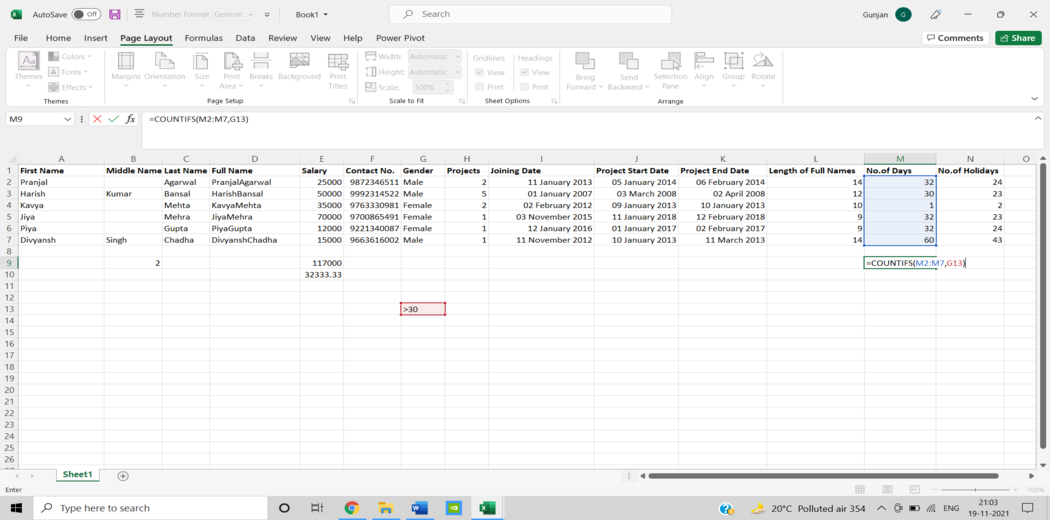
8. Counta()
COUNTA determines whether a cell is empty. As a data analyst, you’ll encounter incomplete data sets daily. COUNTA allows you to examine any gaps in the dataset without needing to restructure the data.
SYNTAX = COUNTA (value1, [value2], …)
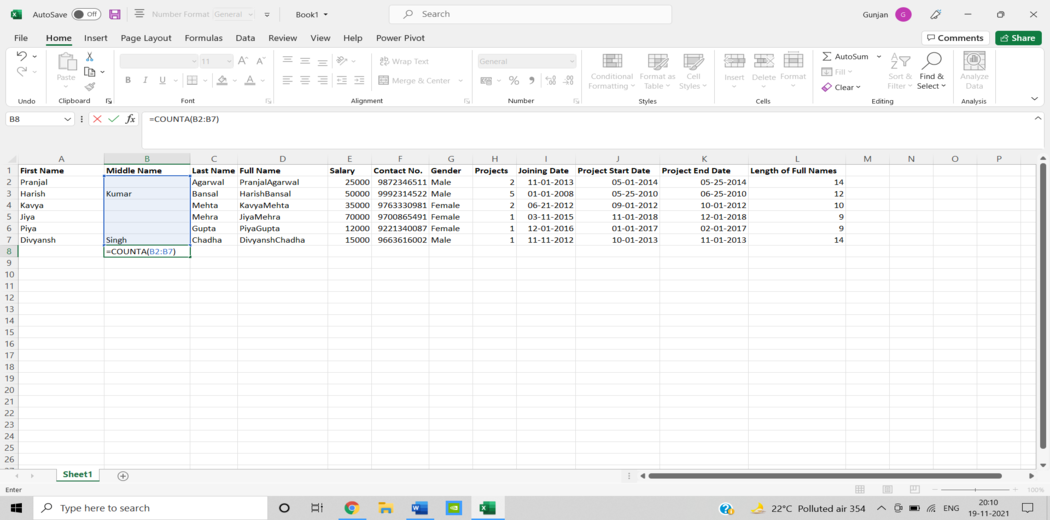
9.Vlookup()
The acronym VLOOKUP stands for ‘Vertical Lookup.’ It’s a function that tells Excel to look for a specific value in a column (the
so-called ‘table array’) to return a value from another column in the same row.
SYNTAX = VLOOKUP (lookup_value, table_array, column_index_num, [range_lookup])
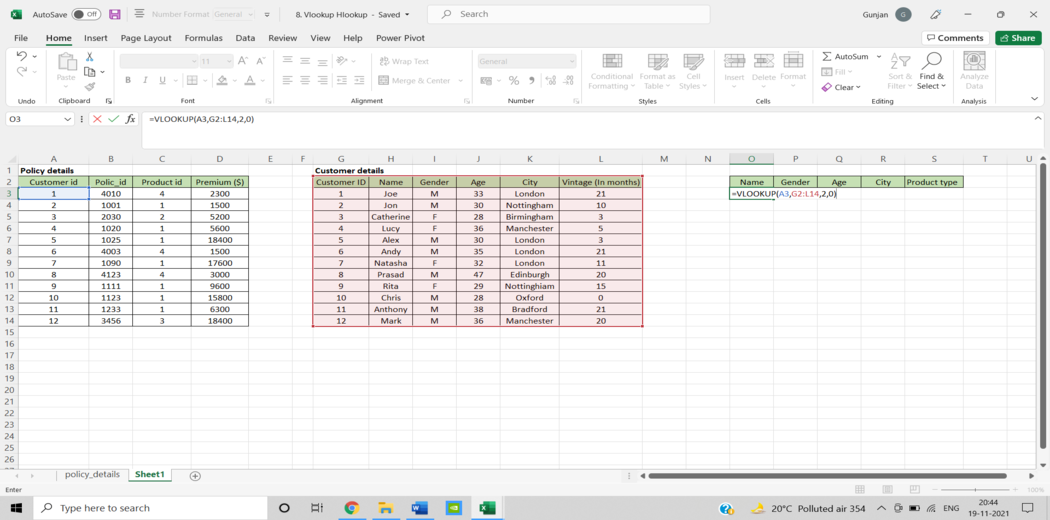
10. Hlookup()
“Horizontal” is represented by the letter H in HLOOKUP. It looks for a value in the top row of a table or an array of values, then returns a value from a row you specify in the table or array in the same column. When your comparison values are in a row across the top of a data table, and you wish to look down a specific number of rows, use HLOOKUP. When your comparison values are in a column to the left of the data you wish to find, use VLOOKUP.
SYNTAX = HLOOKUP (lookup_value, table_array, row_index, [range_lookup])

11. If ()
The IF function comes in handy a lot. We can use this function to automate decision-making in our spreadsheets. We could use IF to make Excel conduct a different computation or show a different value based on the results of a logical test (a decision). The IF function will ask you to run a logical test and tell you what action to take if the test is true and what action to take if the test is false.
SYNTAX = IF (logical_test, [value_if_true], [value_if_false])

12. Iferror()
We could display a more informative error than Excel or even execute an alternative computation using IFERROR. Two things are required for the IFERROR function to work. What value should be checked for an error, and what action should be taken instead?
SYNTAX = IFERROR (value, value_if_error)
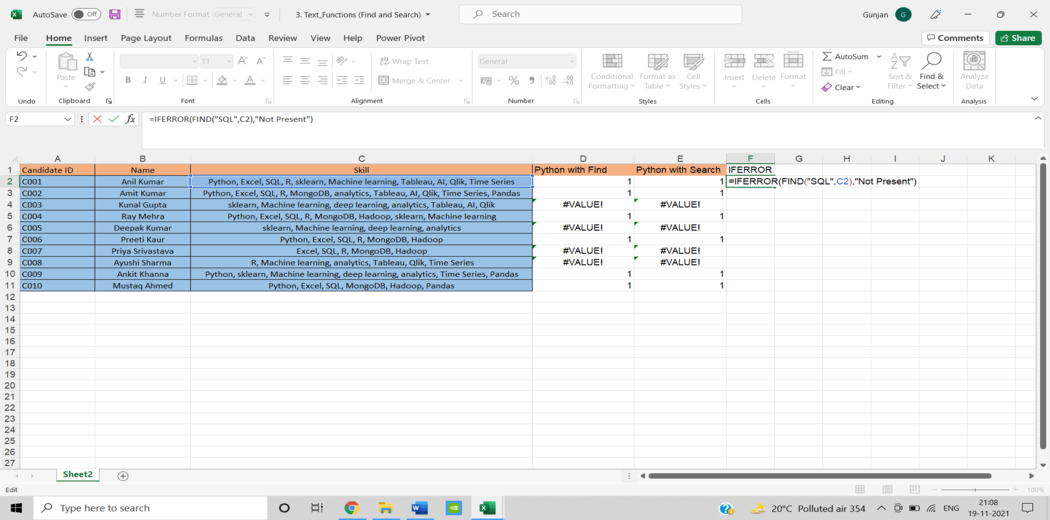
13. Find/Search
The FIND function in Excel returns the position of one text string within another (as a number). If the text cannot be located, FIND delivers a #VALUE error.
However, a =SEARCH for “Bigger” will return results for Bigger or bigger, broadening the scope of the query. This is very helpful when searching for anomalies or unique identifiers.
SYNTAX = FIND (find_text, within_text, [start_num])
SYNTAX = SEARCH (find_text, within_text, [start_num])
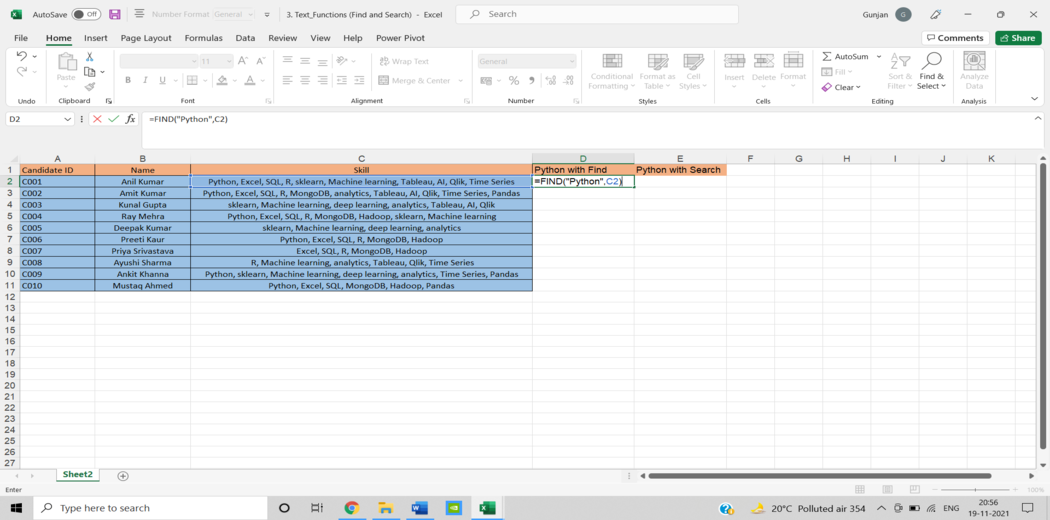
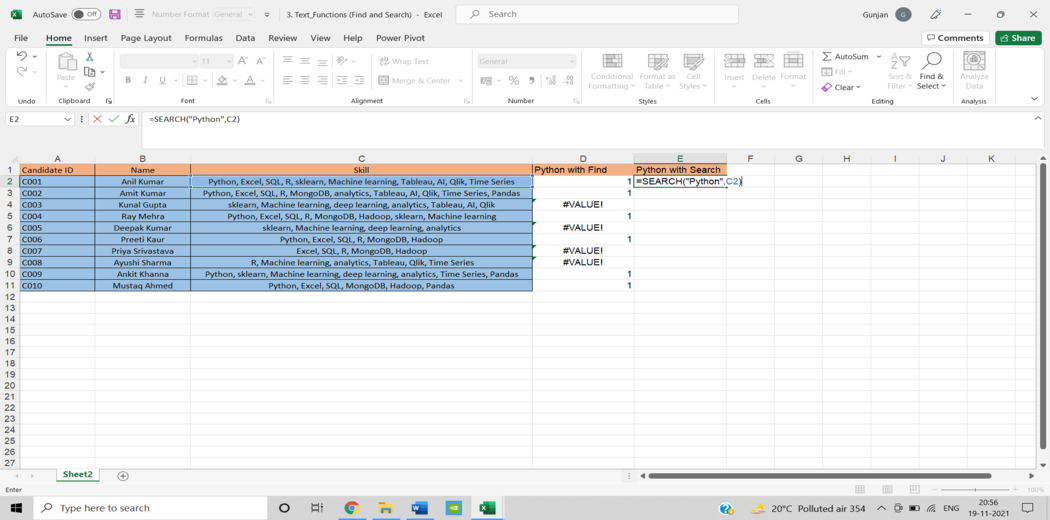
14. Left/Right
=LEFT and =RIGHT are simple and efficient ways of retrieving static data from cells. =RIGHT returns the “x” number of characters from the cell’s end, while =LEFT returns the “x” number of characters from the cell’s beginning. In the sample below, the consumer’s area code is extracted from their phone number using =LEFT, while the last four digits are extracted using =RIGHT.
SYNTAX = LEFT (text, [num_chars])
SYNTAX = RIGHT (text, [num_chars])

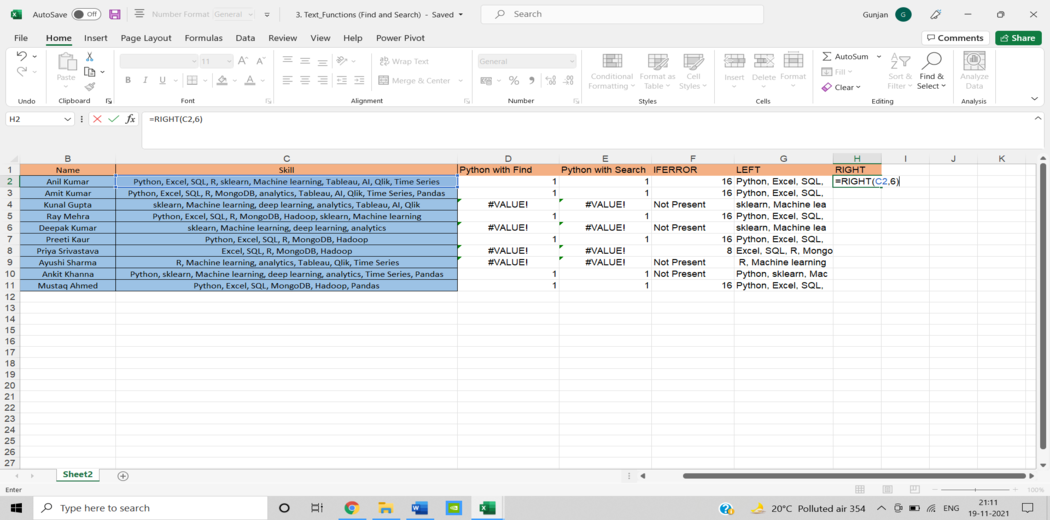
15. Rank()
Even though =RANK is an old Excel function, it is useful for data analysis. =RANK is a quick way to show how values in a dataset rank in ascending or descending order. RANK is being utilized to determine which clients order the most stuff.
SYNTAX = RANK (number, ref, [order])
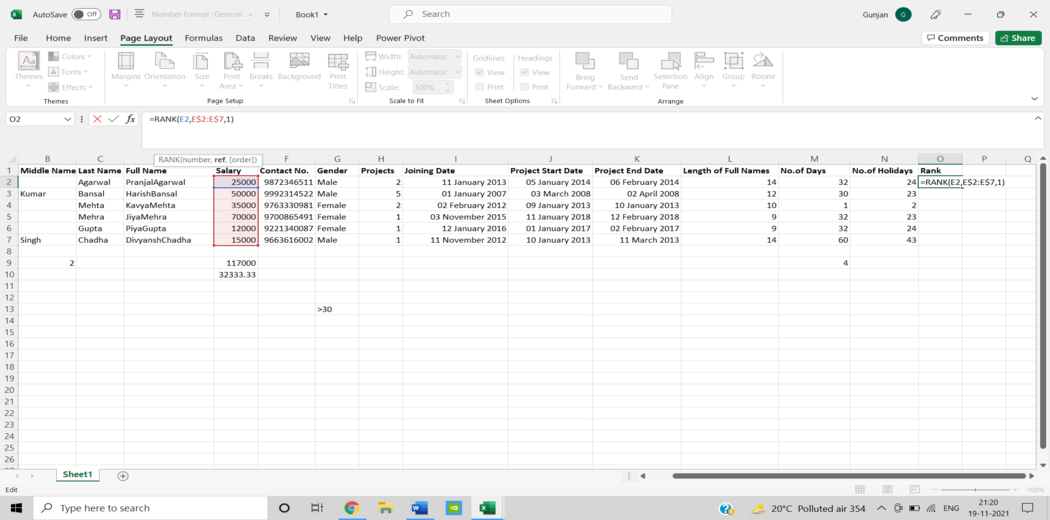
FREE Course on Excel for Data Analysis
Explore this comprehensive Excel Tutorial available on YouTube for those looking to enhance their Excel skills further. It covers various topics and provides valuable insights and techniques for mastering the art of “Excel for data analysis.” Feel free to check out the guide below:
Some of the Methods for Data Analysis in Excel
1. Ranges and Tables
Your information can be in the form of a table or a range. Certain actions can be performed regardless of whether the data is in a range or a table. Certain procedures, however, are more successful when data is stored in tables rather than ranges. Some operations are only applicable to tables. You will also understand how to analyze data in ranges and tables. You’ll learn how to name ranges, how to use them, and how to manage them. The same may be said for table names.
2. Data Cleaning: Text Functions, Dates and Times
Before moving on to data analysis, you must clean and organize the data you’ve gathered from multiple sources. The following approaches can be used to clean data in Excel.
- With Text Functions
- Containing Date Values
- Containing Time Values
3. Conditional Formatting
Conditional formatting instructions in Excel allow you to color cells or fonts and place symbols next to values in cells based on predetermined criteria. This aids in visualizing the most important values.
It allows you to highlight cells with a different color depending on the value you set for them. Rules, data bars, color scales, icon Sets, finding duplicates, shading alternate rows, comparing two lists, conflicting rules, checklists, and creating Heat Maps all benefit from conditional formatting.
4. Sorting and Filtering
You may need to sort and/or filter your data to prepare for data analysis and/or to display specific critical data. You can perform the same in Excel using the simple sorting and filtering options. Sort and Filter are the most used Excel functions. Within columns, sorting can be done in ascending or descending order. Lists can be sorted by color, reversed, or randomly generated. Filters are used to display data that meets requirements. Number and Text Filters, Date Filters, Advanced Filter, Data Form, Remove Duplicates, Outlining Data, and Subtotal are some options.
5. Subtotals with Ranges
PivotTables are commonly used to summarize data, as you are aware. However, Subtotals with Ranges is another Excel function that allows you to group/ungroup data and summarize data in ranges in a few simple steps.
6. QuickAnalysis
You can quickly execute numerous data analysis activities and create quick representations of the results with Excel’s Quick Analysis function.
7. Understanding Lookup Functions
Excel Lookup Functions allow you to search through a large amount of data for data values that fit a set of criteria. Vlookup and Hlookup are two different types of lookup engines. Analysts use Vlookup and Hlookup to discover a value in a database and retrieve other values corresponding to that value. Data analysts frequently use it to integrate and consolidate useful data from several Excel sheets.
8. PivotTables
PivotTables allow you to summarise data and create dynamic reports by modifying the PivotTable’s contents. You can use pivot tables to extract important data from a vast dataset. This is the most practical method of data analysis. After inserting a Pivot Table, you can drag fields, sort, filter, or change the summary calculation. Two-dimensional Pivot Tables are also possible. Group Pivot Table Items, Multi-level Pivot Table, Frequency Distribution, Pivot Chart, Slicers, Update Pivot Table, Calculated Field/Item, and GetPivotData are all important functions.
9. Data Visualization in Excel
Charts are simple to make and display data in various ways, making them more helpful than a sheet. You can make a chart, modify its type, adjust the row or column, the legend location, and the data labels. Column Charts, Line Charts, Pie Charts, Bar Charts, Area Charts, and Scatter Plots are some of the different charts provided in Microsoft Excel.
10. Data Validation
Only valid values may need to be entered into cells. Otherwise, they risk producing erroneous results. Using data validation commands, you can rapidly set up data validation values for a cell, an input message prompting the user on what should be typed in the cell, validate the values provided against the supplied criteria, and display an error message in the case of incorrect entries. It may be necessary to insert only valid values into cells. Otherwise, they could result in inaccurate calculations. You may quickly set up data validation values for a cell, an input message prompting the user on what should be typed in the cell, validate the values entered against the given criteria and display an error message in the case of wrong entries using data validation commands.
11. Financial Analysis
Excel has several financial features. However, you may learn to employ a combination of these functions to solve common situations that need financial analysis.
12. Working with Multiple Worksheets
You may need to run multiple identical calculations in different worksheets. Instead of duplicating these calculations in each worksheet, you can complete them in one and display them in all others. You may also use a report worksheet to compile the data from the multiple worksheets.
13. Formula Auditing
When you utilize formulas, you should double-check that they are working correctly. Formula Auditing commands in Excel assist you in tracing previous and dependent variables and error checking.
14. What-if Analysis
You can extract critical data from a large dataset using pivot tables. What-if analysis is the most practical. After inserting a Pivot Table, you can drag fields, sort, filter, and adjust the summary calculation. Pivot Tables can also be made in two dimensions. The functions of Group Pivot Table Items, Multi-level Pivot Table, Frequency Distribution, Pivot Chart, Slicers, Update Pivot Table, Calculated Field/Item, and GetPivotData are all essential.
Guide on Using Excel for Data Analysis
Let us now look at how to analyze data using Microsoft Excel.
Step 1: DATA CLEANING USING TEXT TO COLUMN
The first step in the process is to clean the data using text to column.
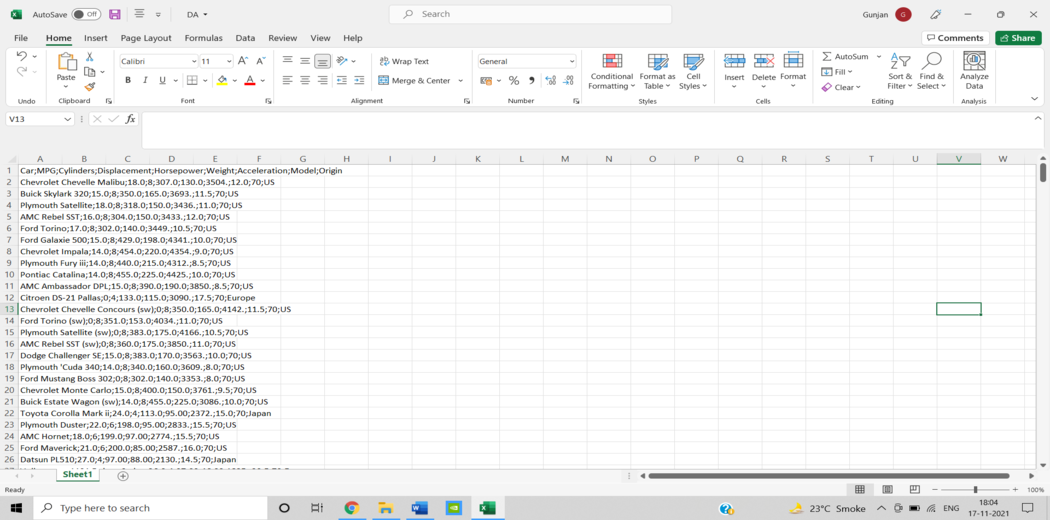
Select the first column, then go to the data and select “text to column.” Select delimited from the appearing window and press next.

Then, to separate the data, select a delimiter/Separator by the dataset requirements. The required delimiter for the given dataset was “; “
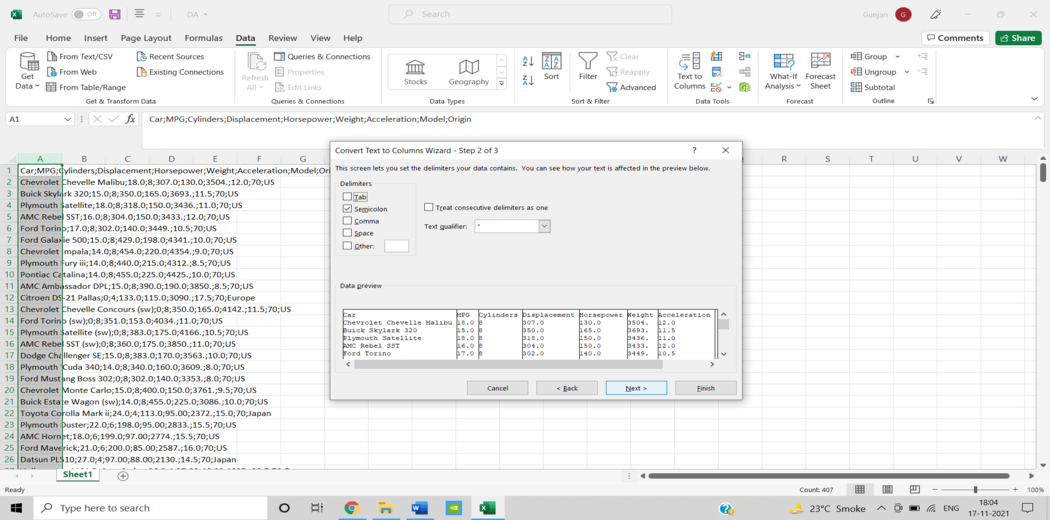
After cleaning the dataset, check for the data preview and finish the process.

Finally, you Will be able to get the cleaned data.
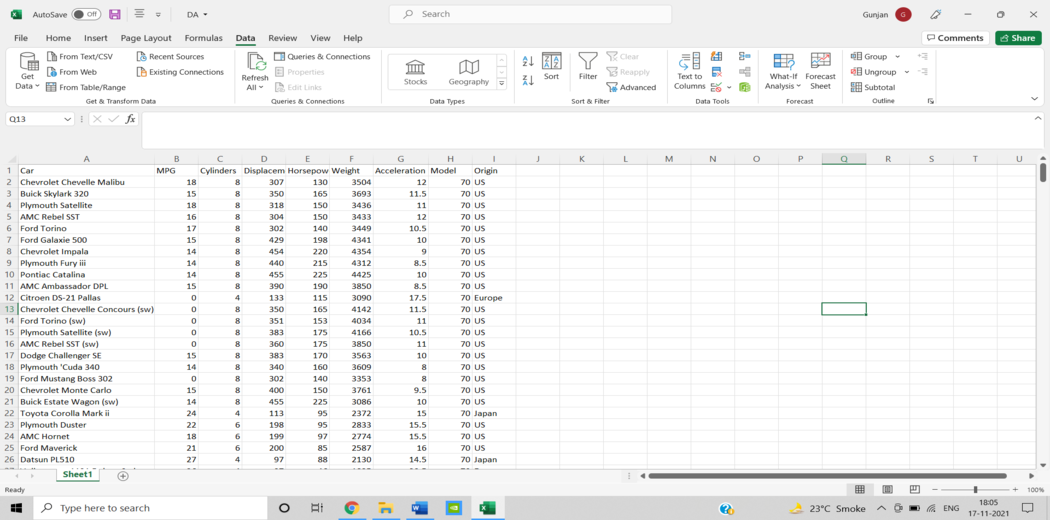
Step 2: CONDITIONAL FORMATTING
The next step is conditional formatting.
You can specify any number of formatting conditions using rules. Highlight cell rules can help you find the appropriate rules.
You can even make up your own set of rules. Furthermore, you can add a rule.
You can remove the existing rule by locating it in your settings or preferences and then selecting the option to delete or disable it.
Keep track of these defined rules.
Select the column for conditional formatting and then select the “conditional formatting” option from the home tab. Many rules will be visible under conditional formatting, so select the rule you want to apply to the column.
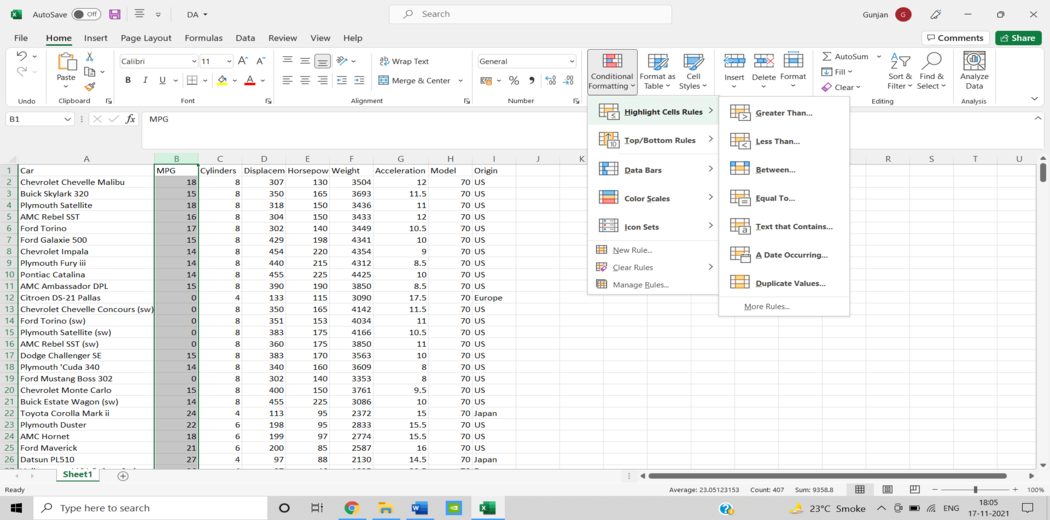
After satisfying the rule, select the required value and the color to be applied to the cells.
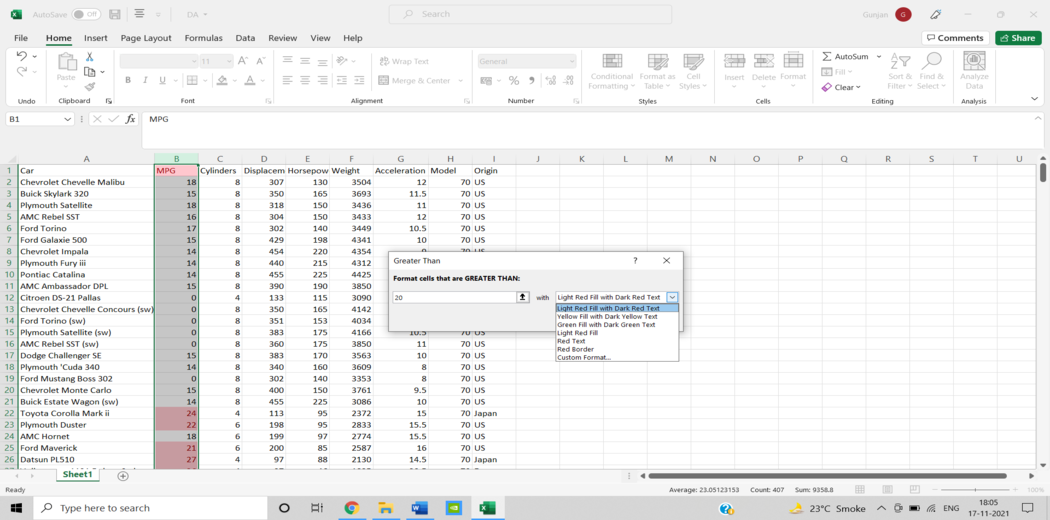
Click finish when you’ve completed all of the required details.
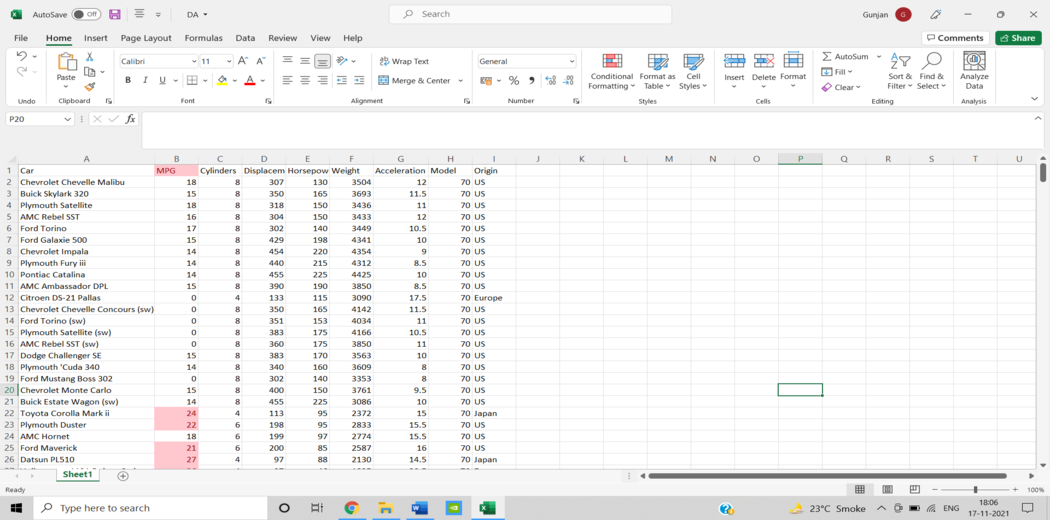
Step 3: SORTING AND FILTERING
To add a filter to a column, select the column, then select the filter option present under data.

You will see a dropdown menu after adding the filter option to a column. Click on that dropdown menu to see all of the available options. You can select the required filter for the column and sort it. This is a handy feature for managing your data effectively, especially when following an Excel tutorial.
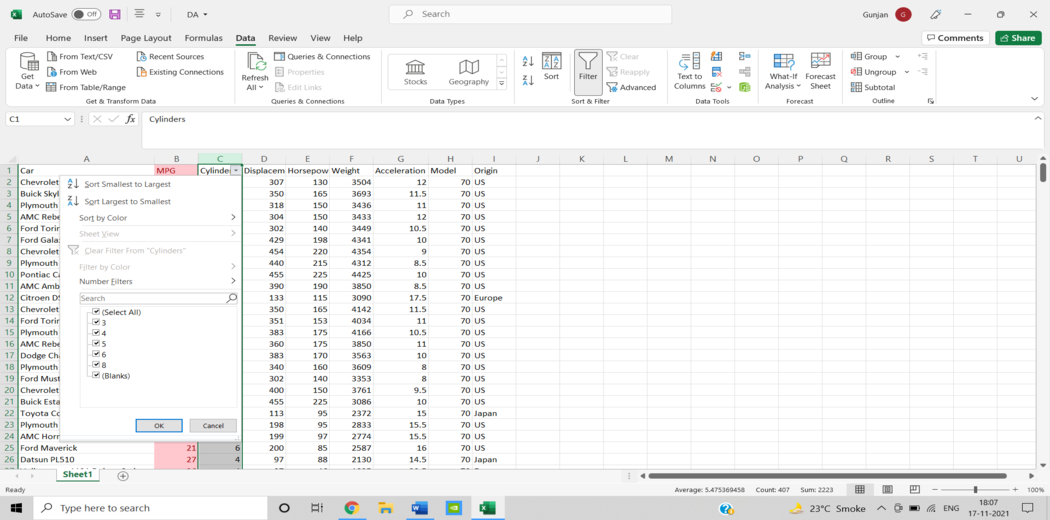
For example, if you only want cars with eight cylinders, then to do so, from the dropdown option, select “8” and click ok to complete.
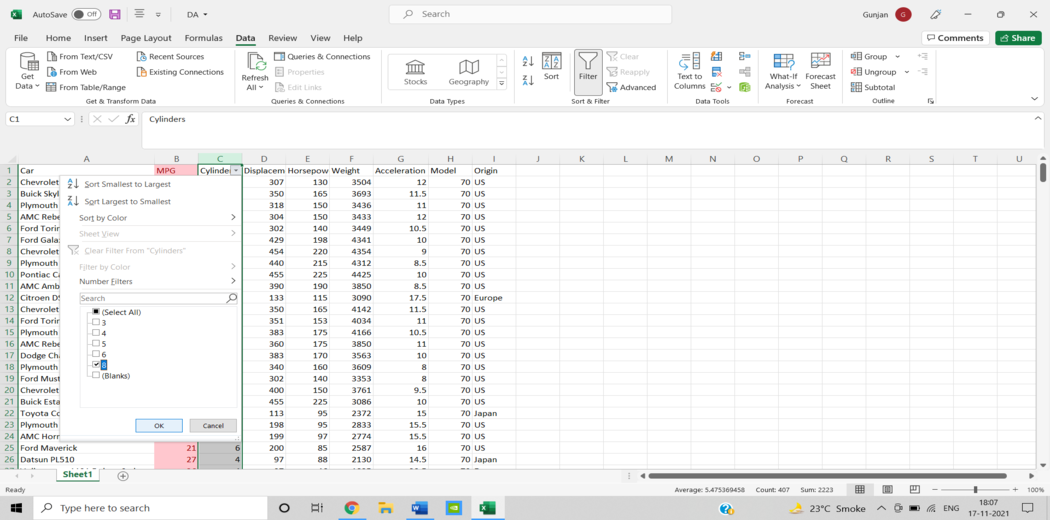
You can see cars with 8 cylinders after selecting the filter condition.
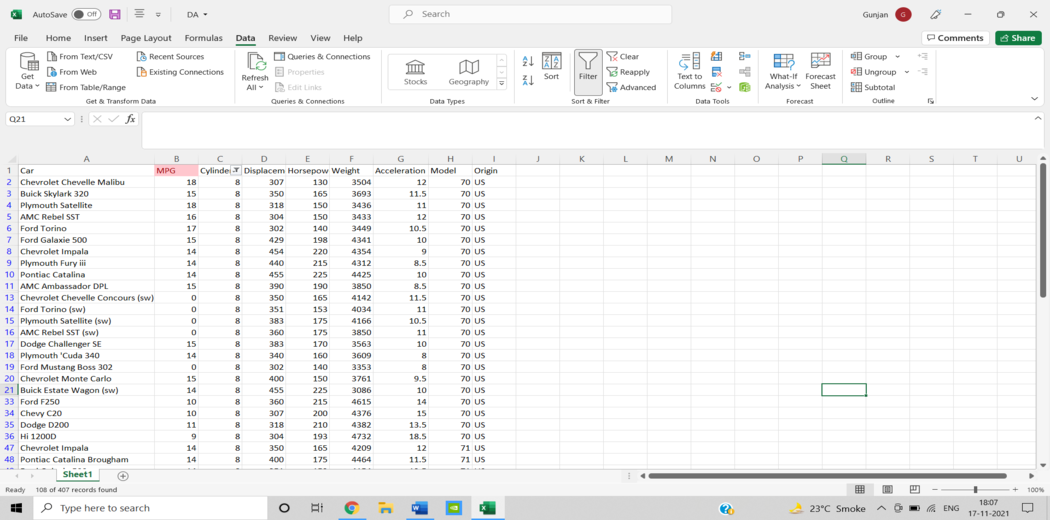
Example: now we need to order the cars in ascending order based on their weight.
Select “sort smallest to largest” from the dropdown option.

The cars are now ordered in ascending order based on their weight.
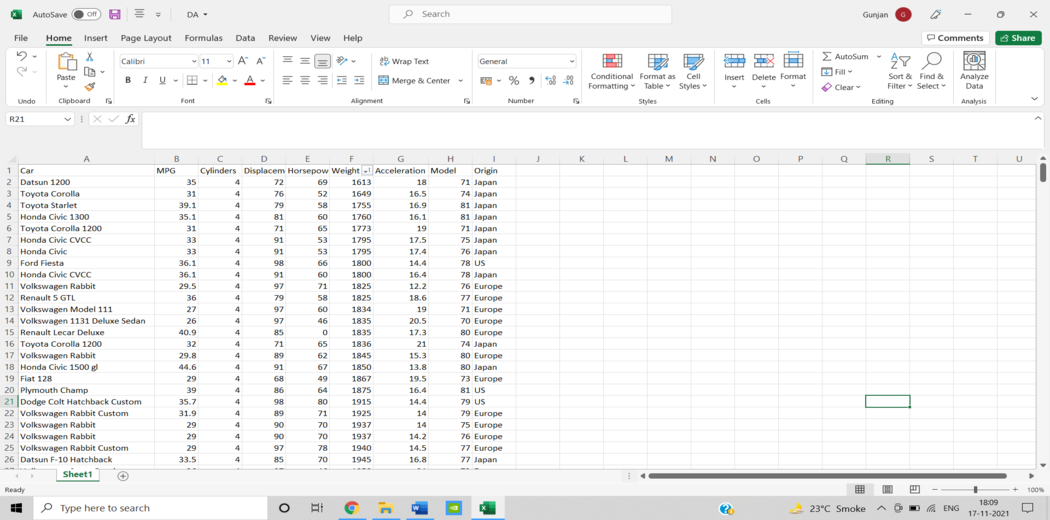
Step 4: PIVOT TABLES
Press cntrl-a, then go to insert and click on the pivot table option. A dialogue box will open under which you must select “new worksheet” for the pivot table to be placed, followed by clicking ok. This Excel tutorial guides you through the process step by step.
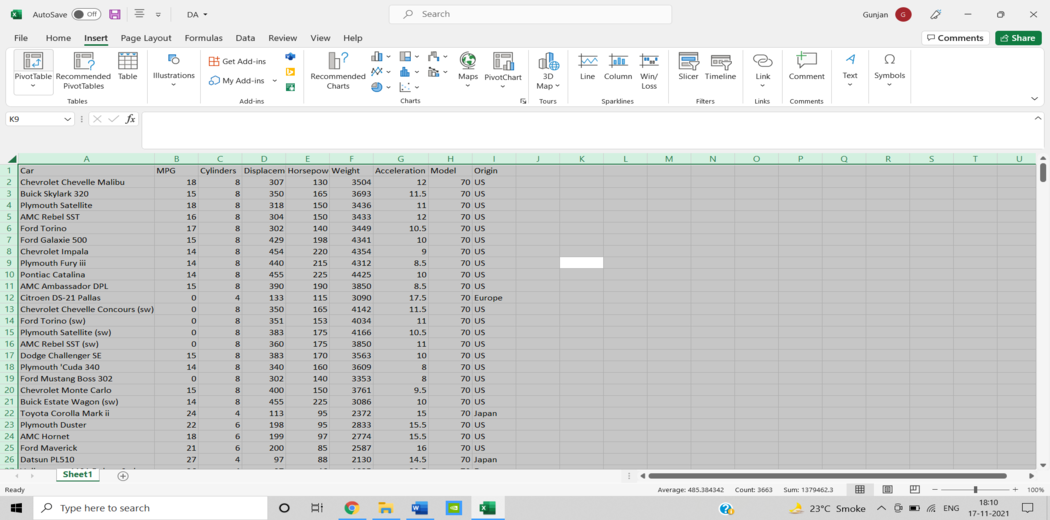
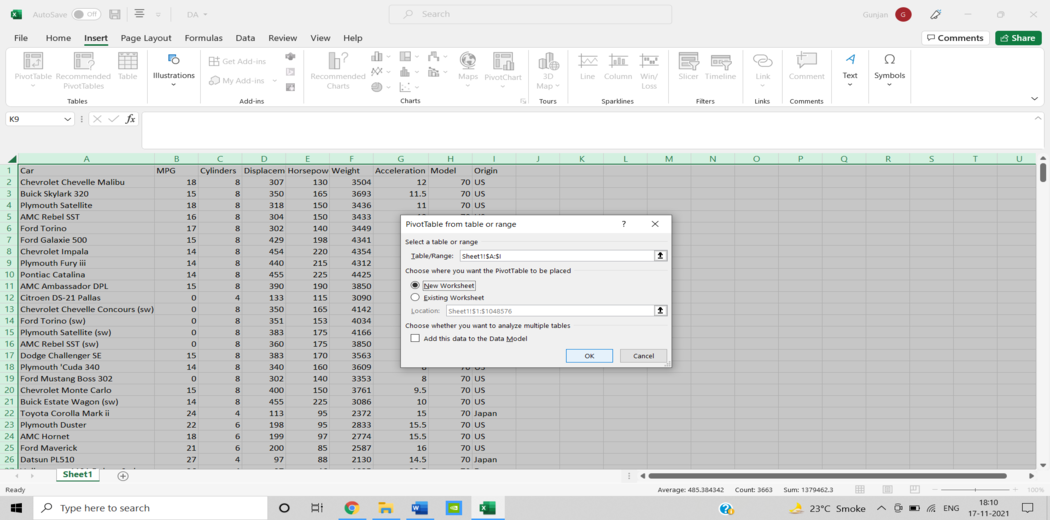
After completing the above step, your Excel file will include a new sheet like this. On the right side of the sheet, you will see fields from your data and options for the pivot table, such as filters, rows, values, and columns. This pivot table functionality enhances your Excel tutorial, empowering you to analyze and visualize your data effectively.
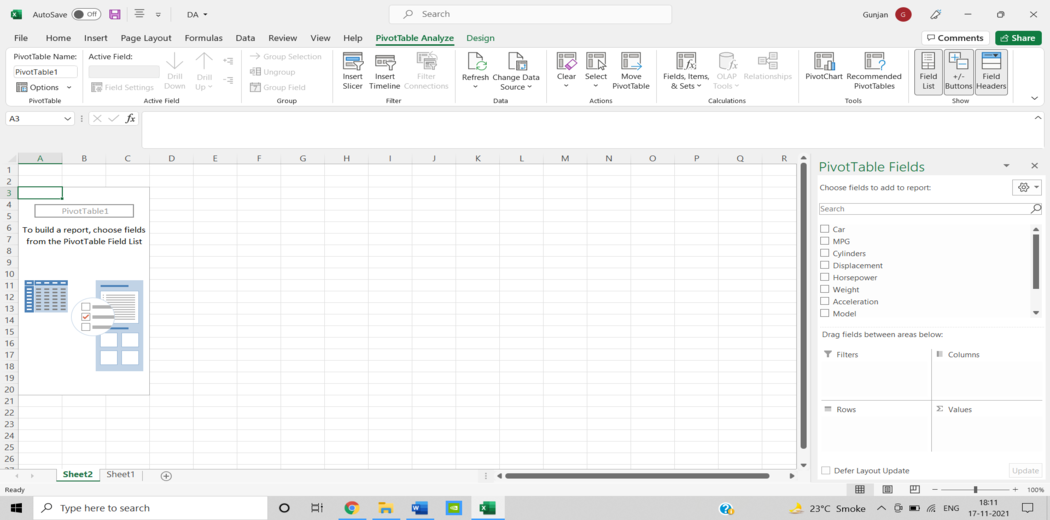
To create a pivot table, drag and drop the required fields according to the options provided by the pivot table feature. For example, we would like to check the sum of cylinders for all the cars, which are differentiated by their origin. If you’re new to pivot tables, don’t worry! Check out our Excel tutorial for step-by-step guidance on how to create and use pivot tables effectively.

For example, we would like to check the “sum of horsepower” for all the cylinders based on their origin.
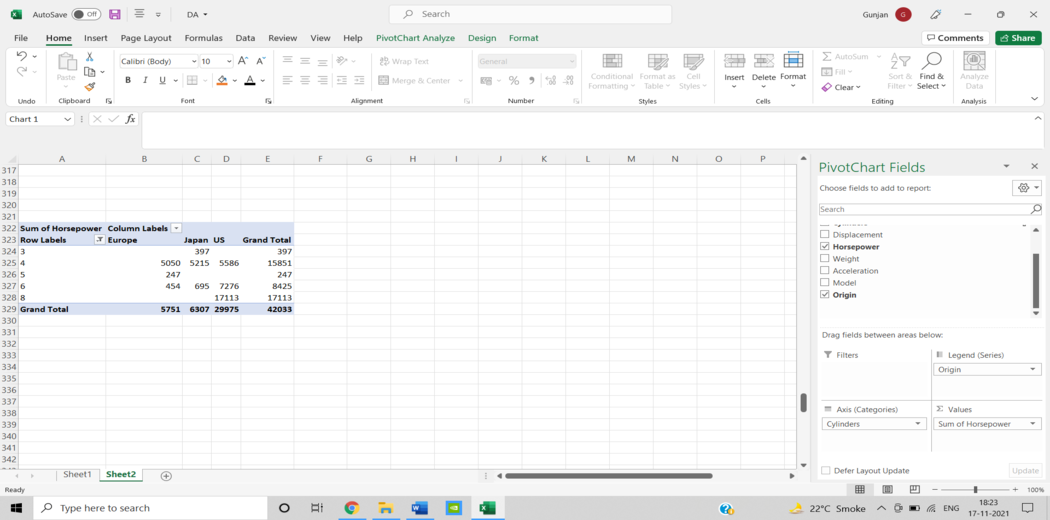
We can deduct the following from the above step: –
- A car with 3 cylinders originated only in Japan, while the maximum horsepower of cars with 4 cylinders originated from “us.”
- In Europe, cars with 5 cylinders originate exclusively.
- The maximum horsepower of the cars with 6 cylinders originated from “us.”
- Cars with 8 cylinders originated only in “us.”
Simple Linear Regression Model in Microsoft Excel
Let us now look at a simple linear regression model in Microsoft Excel.
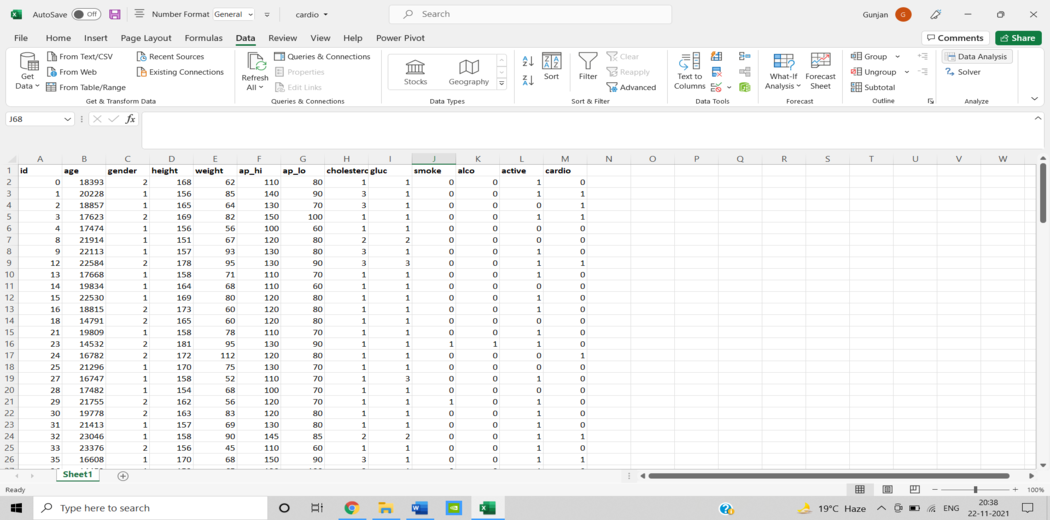

4. In the Regression dialogue box, pick the dependent variable data in the “Input Y Range” box (cardio column).
5. Select the independent variable data in the “Input X Range” box.
6. Select “Labels” from the drop-down menu
7. Select the output range by clicking in the Output Range box.
8. Select “Residuals” from the drop-down menu
9. To complete the process, click OK
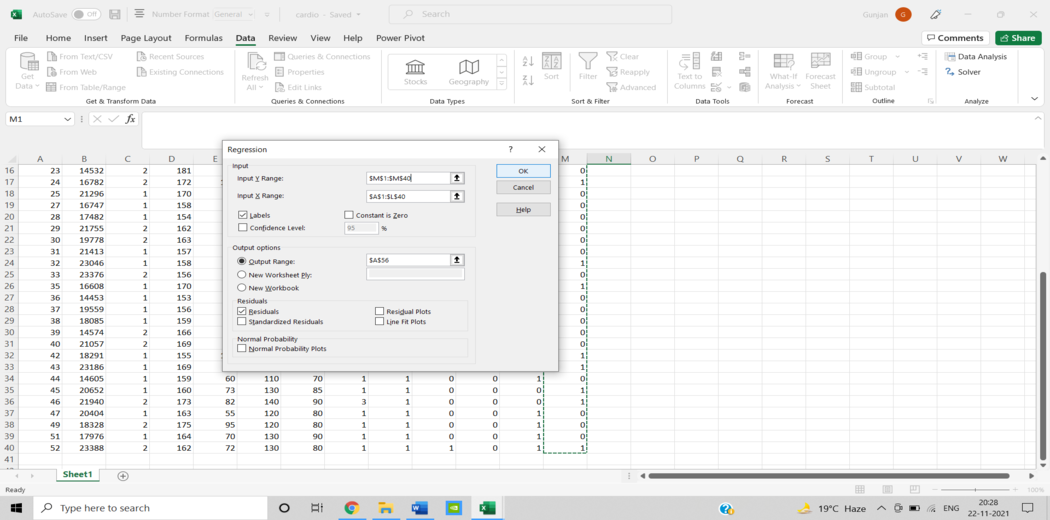
10. Finally, you’ll obtain an Excel spreadsheet with a simple linear regression model. You can now evaluate the results.
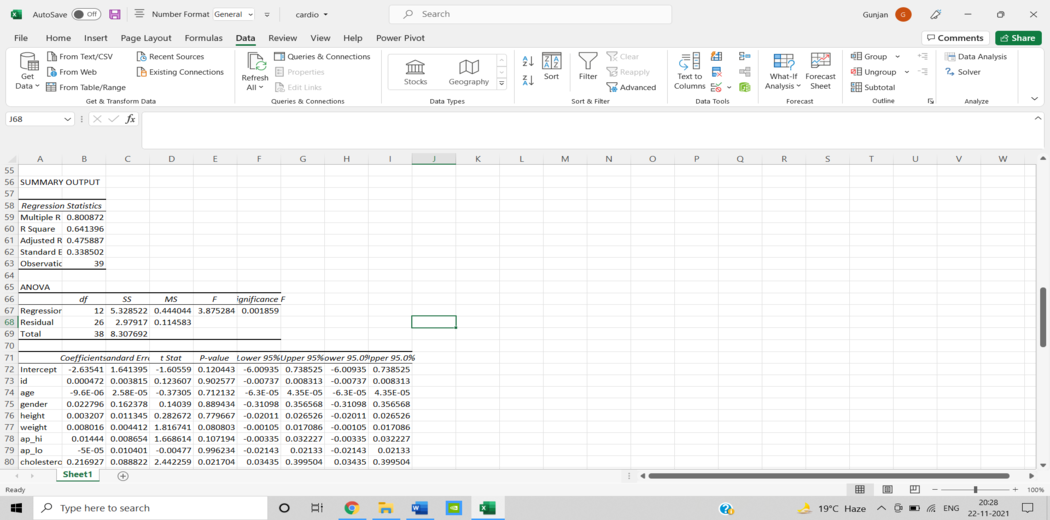
The R2 number, also known as the coefficient of determination, naturally indicates how well the regression model fits the data by measuring the proportion of variance in the dependent variable explained by the independent variable. Data analysis in Excel often involves closely examining the R2 value. This numerical representation ranges from 0 to 1, with a higher number suggesting a better match between the model and the data. Additionally, the p-value, also known as the probability value, plays a crucial role in the Excel tutorial. This numeric measure ranges from 0 to 1 and provides insights into the significance of a test. Contrary to the R2 value, a smaller p-value is preferred, as it indicates a stronger likelihood of correlation between the dependent and independent variables. Understanding these metrics is essential for proficient data analysis in Excel.
Dataset in Excel for Data Analysis
- The dataset used for Data Analysis in Microsoft Excel
It’s a dataset of roughly 400 cars with eight attributes, including car name, mpg, cylinders, displacement, horsepower, acceleration, weight, origin, and model. You can Click here to learn more datasets in Excel
- The dataset used for the Simple Linear Regression Model in Microsoft Excel.
It’s a dataset of cardiovascular patients with eleven different independent variables, including gender, age, height, weight, etc. Also, you can check here for Simple Linear Regression and more about the Excel tutorial
Conclusion
In conclusion, Excel is an indispensable data analysis tool thanks to its robust features and versatility. The extensive functionalities, such as pivot tables, data cleaning tools, conditional formatting, and various statistical functions, make it a preferred choice across industries, from finance to marketing. This comprehensive guide underscores the essential role of Excel in data analysis, providing insights into the key topics and techniques required to harness its full potential. Embracing these tools and methods will significantly enhance your ability to perform sophisticated data analysis using Excel, ensuring you stay competitive in today’s data-driven landscape.
Key Takeaways
- Excel provides a powerful platform for organizing, analyzing, and visualizing large datasets across various industries, facilitating better decision-making and strategic planning.
- Excel’s wide range of built-in functions simplifies complex data analysis tasks, from summing and averaging data based on criteria to performing lookup operations and ranking data.
- Data cleaning is crucial for accurate analysis. Excel offers text functions, date and time functions, and tools like Text to Columns to prepare data for analysis.
- Pivot tables are essential for summarizing large datasets and generating dynamic reports. They enable users to explore and analyze data from different perspectives easily.
Excel is a naturally crucial tool for data analysis, and it offers a range of features that enable users to manipulate and analyze large amounts of data efficiently. With our BlackBelt Data Science program, you can learn advanced techniques for data analysis in Excel, including data visualization, machine learning, and statistical modeling specifically tailored for “Excel for data analysis.” The program provides practical training that allows you to apply these techniques to real-world problems, making you a naturally proficient expert in data analysis. Enroll now!
The media shown in this article is not owned by Analytics Vidhya and are used at the Author’s discretion.
Frequently Asked Questions
A. Commonly used Excel formals are SUM, AVERAGE, MAX, MIN, COUNT, IF, VLOOKUP, and INDEX-MATCH. They can manipulate and summarize data, perform calculations, and make decisions based on specific criteria.
A. One can practice Excel for data analysis using various online platforms that provide courses and projects to help improve Excel skills, including Coursera, Udemy, LinkedIn Learning, and Excel Easy. Additionally, one can practice using Excel for data analysis by working on real-world projects and challenges, such as analyzing business data or financial statements.
A. The time it takes to learn Excel for data analysis can vary based on your prior experience and the depth of knowledge you wish to achieve. For beginners with no prior experience, gaining a basic proficiency in Excel might take about 1-2 months with consistent practice.
A. Excel is a powerful tool for basic data manipulation, cleaning, and exploration, which are essential data science skills. Furthermore, Excel is widely used across industries, making it a valuable skill for communicating and sharing data insights with non-technical stakeholders.








Great, and informative to learn
Nice! Very informative
Thanks Arif 😊 Glad you liked it !
I am interested in learning data science
Thank you so much for this tutorial, it has been extremely helpful!
Glad you liked it Mona 😊
It is a good and easy content to understand.
Ts very nice and I have loved it. Thank you so much
Comments are Closed